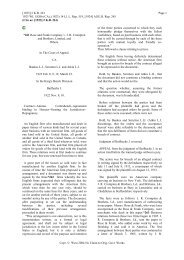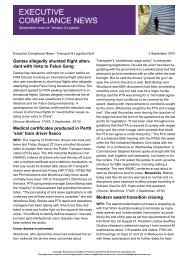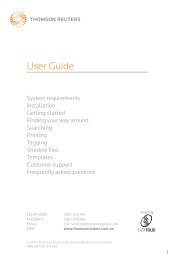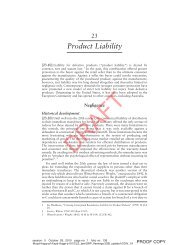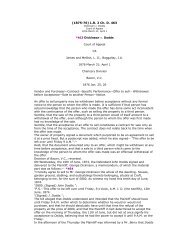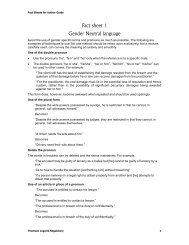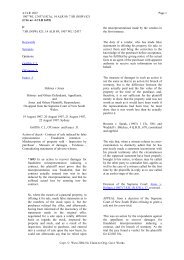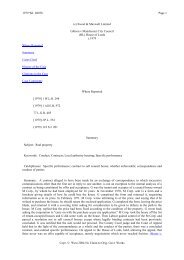Tesco v Constain - Thomson Reuters
Tesco v Constain - Thomson Reuters
Tesco v Constain - Thomson Reuters
You also want an ePaper? Increase the reach of your titles
YUMPU automatically turns print PDFs into web optimized ePapers that Google loves.
2003 WL 21729349 Page 592003 WL 21729349 (QBD (T&CC)), [2003] EWHC 1487(Publication page references are not available for this document.)builder constructed the building by virtue of thecontract between them.211. The actual decision in Murphy v. BrentwoodDistrict Council was that the previous decision ofthe House of Lords in Anns v. Merton LondonBorough Council [1978] AC 728 was wrong andthat a local authority charged with securingcompliance with Building Regulations did not owea duty of care in the performance of that function tobuilding owners such that building owners couldrecover damages in respect of economic losssustained as a result of breach of BuildingRegulations which the local authority ought to havedetected and prevented. A convenient, succinctrehearsal of the relevant considerations so far as theliability of the builder is concerned can be found inthe speech of Lord Bridge of Harwich at page475A-H:--"If a manufacturer negligently puts intocirculation a chattel containing a latent defectwhich renders it dangerous to persons or property,the manufacturer, on the well known principlesestablished by HDonoghue v. Stevenson [1932] AC562, will be liable in tort for injury to persons ordamage to property which the chattel causes. But ifa manufacturer produces and sells a chattel whichis merely defective in quality, even to the extentthat it is valueless for the purpose for which it isintended, the manufacturer's liability at commonlaw arises only under and by reference to the termsof any contract to which he is a party in relation tothe chattel; the common law does not impose onhim any liability in tort to persons to whom heowes no duty in contract but who, having acquiredthe chattel, suffer economic loss because the chattelis defective in quality. If a dangerous defect in achattel is discovered before it causes any personalinjury or damage to property, because the danger isnow known and the chattel cannot safely be usedunless the defect is repaired, the defect becomesmerely a defect in quality. The chattel is eithercapable of repair at economic cost or it is worthlessand must be scrapped. In either case the losssustained by the owner or hirer of the chattel ispurely economic. It is recoverable against any partywho owes the loser a relevant contractual duty. Butit is not recoverable in tort in the absence of aspecial relationship of proximity imposing on thetortfeasor a duty of care to safeguard the plaintifffrom economic loss. There is no specialrelationship between the manufacturer of a chatteland a remote owner or hirer.I believe that these principles are equallyapplicable to buildings. If a builder erects astructure containing a latent defect which renders itdangerous to persons or property, he will be liablein tort for injury to persons or property resultingfrom that dangerous defect. But if the defectbecomes apparent before any injury or damage hasbeen caused, the loss sustained by the buildingowner is purely economic. If the defect can berepaired at economic cost, that is the measure of theloss. If the building cannot be repaired, it may haveto be abandoned as unfit for occupation andtherefore valueless. These economic losses arerecoverable if they flow from breach of a relevantcontractual duty, but, here again, in the absence ofa special relationship of proximity they are notrecoverable in tort. The only qualification I wouldmake to this is that, if a building stands so close tothe boundary of the building owner's land that afterdiscovery of the dangerous defect it remains apotential source of injury to persons or property onneighbouring land or on the highway, the buildingowner ought, in principle, to be entitled to recoverin tort from the negligent builder the cost ofobviating the danger, whether by repair or bydemolition, so far as that cost is necessarilyincurred in order to protect himself from potentialliability to third parties."Mr. Stewart contended that that passage also wasconsistent with the principle which in hissubmission was to be extracted from the decision.212. Other issues which have arisen during thecourse of the development of the law of negligencehave included the question of liability foromissions, rather than acts of commission, and thequestion of the interrelationship of liability incontract, on the one hand, and in negligence, on theother. In respect of the latter issue Lord Scarman,delivering the advice of the HPrivy Council in TaiHing Cotton Mill Ltd. v. Liu Chong Hing BankLtd. [1986] AC 80 at page 107 did say, obiter:--"Their Lordships do not believe that there isanything to the advantage of the law's developmentin searching for a liability in tort where the partiesare in a contractual relationship. This is particularlyso in a commercial relationship. Though it ispossible as a matter of legal semantics to conductan analysis of the rights and duties inherent in somecontractual relationships including that of bankerand customer either as a matter of contract lawwhen the question will be what, if any, terms are tobe implied or as a matter of tort law when the taskwill be to identify a duty arising from the proximityand character of the relationship between theparties, their Lordships believe it to be correct inprinciple and necessary for the avoidance ofconfusion in the law to adhere to the contractualanalysis: on principle because it is a relationship inwhich the parties have, subject to a few exceptions,the right to determine their obligations to eachother, and for the avoidance of confusion becausedifferent consequences do follow according towhether liability arises from contract or tort, e.g. inthe limitation of action."Copr. © West 2004 No Claim to Orig. Govt. Works



